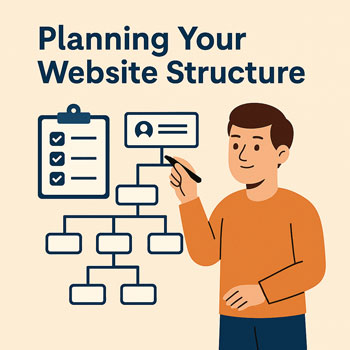
Planning Your Website Structure
Learn how to plan a clear, intuitive website structure before building your pages. A well-organized site improves user experience, SEO, navigation, and conversions.
Learning Objectives
- Understand the purpose of site structure and information hierarchy.
- Create a sitemap and logical navigation flow.
- Group related content into pages and sections.
- Plan navigation menus, footer links, and content clusters.
- Design user journeys that support business goals.
Why Website Structure Matters
A strong structure ensures visitors can find what they need quickly. It also signals relevance to search engines and improves conversions.
Benefits
- Better User Experience: Clear paths reduce confusion.
- Higher SEO Rankings: Organized content helps Google crawl your site.
- Faster Page Creation: You already know which sections every page needs.
- Improved Conversions: Visitors move logically toward CTAs.
Key Elements of Website Structure
- Main Navigation: Top-level pages users access from the header.
- Subpages: Supporting pages inside a logical category.
- Footer Links: Utility pages such as legal policies and secondary navigation.
- User Journeys: The paths you want visitors to take toward your goals.
Step 1: Define Your Website Goals
Your goals determine what content and pages you need. Ask:
- What do I want users to do? (Call, order, book, subscribe, learn)
- What information do they need before taking action?
- What objections must be addressed? (pricing, trust, clarity)
Example Goals
- Generate leads → Need service pages, testimonials, contact page, CTAs.
- Sell products → Need shop, product pages, categories, cart/checkout.
- Build authority → Need blog, about, resources.
Step 2: Create a Simple Sitemap
A sitemap is a high-level outline of all pages on your website.
Common Page Structure
- Home
- About
- Services
- Service 1
- Service 2
- Service 3
- Portfolio / Projects
- Blog
- Contact
Keep your top-level navigation between 4–7 main items for clarity.
Step 3: Group Content Into Logical Categories
Organize related topics together. This helps with navigation and SEO.
Examples
- Services: All service descriptions, pricing, process steps.
- Resources: Blog posts, guides, FAQs.
- Trust: Testimonials, case studies, certifications.
- Contact: Forms, support details, location map.
Step 4: Map the User Journey
Plan how visitors go from awareness → interest → action.
Simple User Flow Example
- User lands on Homepage.
- User clicks a Service overview or featured link.
- User reads detailed service info.
- User sees testimonials or proof.
- User clicks CTA to contact or request a quote.
Every step should be clear and easy to follow.
Website Structure Examples
Small Service Website
- Home
- About
- Services (with subpages)
- Testimonials
- Contact
Medium Business Website
- Home
- About
- Services
- Portfolio/Projects
- Blog
- Contact
Ecommerce Website
- Home
- Shop
- Categories
- Product Pages
- Cart
- Checkout
- Account
Common Mistakes to Avoid
- Adding too many menu items without clear hierarchy.
- Creating duplicate or overlapping pages.
- Burying important information deep in the site.
- Skipping the sitemap and jumping straight into design.
- Using unclear page names (e.g., “Solutions” instead of “Services”).
Activity: Create Your Website Structure
- Define your website’s main goal.
- Create a simple sitemap with all pages you plan to build.
- Group pages into logical categories.
- Plan your main navigation (4–7 items).
- Create a footer navigation list.
Deliverable: Submit your sitemap and navigation plan as a simple list or diagram.
